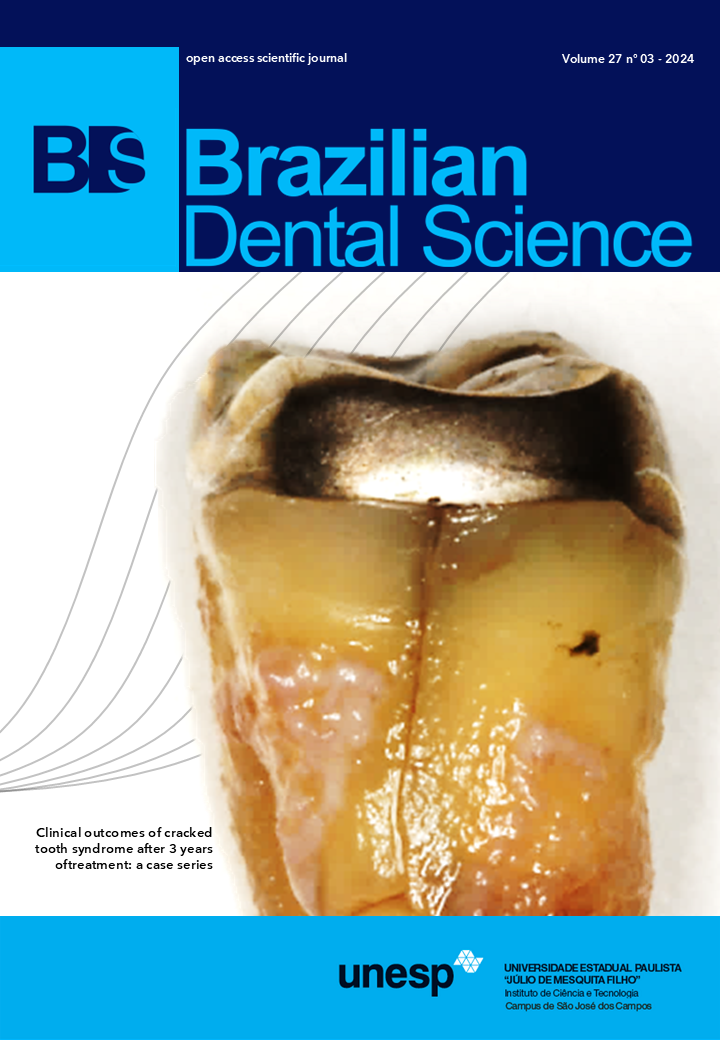Compatibility between variable taper mechanized instruments and corresponding gutta-percha cones: photomicrograph analysis
DOI:
https://doi.org/10.4322/bds.2024.e4270Resumo
Objective: This study aimed to assess the compatibility between variable taper NiTi instruments and corresponding gutta-percha cones. Material and Methods: Protaper Gold F2 (F2/PTG), Wave One Gold Primary (PRI/WOG), and Reciproc Blue R25 (R25/RB) instruments (n = 3) were included, along with corresponding gutta-percha cones (n = 10), produced by the manufacturers and from three other brands (Diadent, MK Life, and Tanari). Images of both instruments and cones were obtained through photomicrographs using a digital microscope (500x). The instruments were photographed at seven angles, rotating on their axis to record the maximum diameter at desired levels; the gutta-percha cones, due to their cross-section, were photographed only once. The images were analyzed using Image J software by a blinded operator at 1.0 (D1), 6.0 (D6), and 12.0 (D12) millimeters from their tip. ANOVA and Tukey tests were employed for statistical analysis, with significance set at 5.0%. Results: Considering the correspondence between F2/PTG and PRI/WOG instruments, significant differences were observed when the manufacturer’s cones were analyzed (P < 0.05). In relation to R25/RB instruments, statistical differences were observed only for the Tanari cone at D1 (P < 0.05). Conclusion: Within the study’s limitations, it can be concluded that the tested instrument systems and dedicated gutta-percha cones exhibited some dimensional variability among them. Furthermore, among the evaluated cones, the cones corresponding to F2/PTG and PRI/WOG instruments from the manufacturer itself showed the greatest discrepancies.
KEYWORDS
Endodontics; Gutta-Percha; Photomicrography; Root canal preparation; Root canal obturation.
Downloads
Downloads
Publicado
Como Citar
Edição
Seção
Licença
TRANSFERÊNCIA DE DIREITOS AUTORAIS E DECLARAÇÃO DE RESPONSABILIDADE
Toda a propriedade de direitos autorais do artigo "____________________________________________________________________" é transferido do autor(es) para a CIÊNCIA ODONTOLÓGICA BRASILEIRA, no caso do trabalho ser publicado. O artigo não foi publicado em outro lugar e não foi submetido simultaneamente para publicação em outra revista.
Vimos por meio deste, atestar que trabalho é original e não apresenta dados manipulados, fraude ou plágio. Fizemos contribuição científica significativa para o estudo e estamos cientes dos dados apresentados e de acordo com a versão final do artigo. Assumimos total responsabilidade pelos aspectos éticos do estudo.
Este texto deve ser impresso e assinado por todos os autores. A versão digitalizada deverá ser apresentada como arquivo suplementar durante o processo de submissão.
























